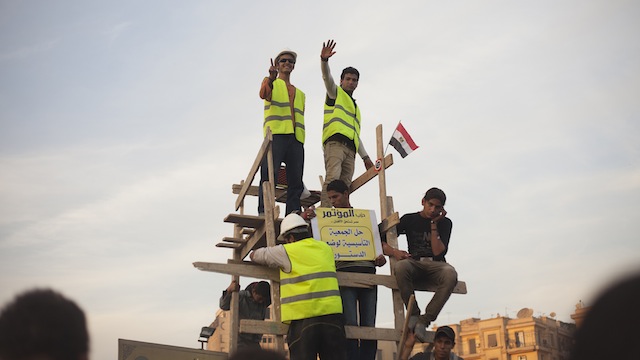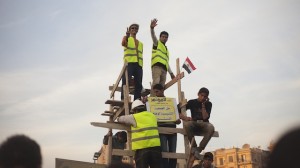My piece for Gawker: In the absence of official security, civilian task forces have formed to deter and intervene against mob sexual assaults during protests in Tahrir Square.
CAIRO, EGYPT— The area between the Hardee’s and Pizza Hut, on a dark and narrow road off of Tahrir Square, has become known as the “Bermuda Triangle.” This is where women’s bodies seem to disappear into the chaos and anger ripping through protesting crowds.
From above, a mob sexual assault in Tahrir looks like a hurricane, picking up speed and engulfing women in a flash — their screams drowned out amid the roar of protesters’ chants.
On the ground, the damage that’s done in a matter of minutes drags on in slow motion — as familiar faces melt into the melee, leaving victims alone with grasping hands.
The women emerge, “naked, bruised, and traumatized,” as ambulance drivers and paramedics described the four sexually assaulted women they’d seen in Tahrir Square the previous week. While these uniformed men admit that “it’s our duty to help everyone,” they also provide an ever-so-thoughtful solution to lessen the burden on everyone: “Girls shouldn’t be in this crowd with men.”
In a deeply divided Egypt, massive protests by supporters and opponents of President Morsi show no signs of stopping ahead of a constitution referendum scheduled for December 15. There’s lots of time ahead for more potential mob sexual assaults.
Many protesters in Tahrir suspect that mob assaults are carried out by men hired by the government, since both the timing and location of the attacks are usually the same. An upcoming UK Channel 4 Unreported World documentary (airing December 7) features interviews with men who claim to have been paid to attack female protesters. Whether or not this is true, many women have been scared away from the square.
Such harrowing tales fly in the face of Tahrir’s symbolic importance as an equal space for discussion and unity for all Egyptians.
Last Tuesday, the day of a large opposition rally, the thought of women having to choose between staying home or being targeted for rape during crucial protests was one that Salma Badawi* could not bear.
“I was furious that simply because I’m a woman,” Salma explains, “I have to adjust my appearance or behavior just to be able to freely express my political views in public.”
Plain and simple, she wanted direct, immediate action for the security (or lack thereof) of female protestors. And she meant business: On Wednesday, Salma paid nearly 5000LE Egyptian pounds (over $800 USD) out of her own pocket for 200 vests and helmets. She was anticipating violence.
“Mob assaults in Tahrir are an entirely different beast than everyday harassment outside. They need to be tackled head on, right now,” says the 29-year-old human resources manager.
In the interest of preserving the integrity of Tahrir Square at the heart of an ongoing revolution, a few civilian groups have emerged to protect female protesters. However, given their limited resources, they have been largely ineffective against combating mob assaults. Counter-protests may be one thing, but “counter-mobs” are much more difficult to assemble.
“One of the beautiful things about Tahrir Square is that even if you’re there alone, you never really feel alone,” says Salma. A strong sense of solidarity comes across both within the square and online, even in its most tense moments.
“You can connect with thousands of helpful people in the square through Twitter,” she says. At its peak, up to 500 people are using Twitter during a protest in Tahrir, according to independent research by business owner Hany Rasmy.
So when Salma felt at her most vulnerable last Tuesday, preparing for a battle of defense against swarms of men at a protest, she rallied the Twitter troops.
Inspired by Tahrir Supplies, an altruistic Twitter account used to coordinate emergency relief efforts in Tahrir and across Egypt, Salma founded Tahrir Bodyguard to immediately get boots on the ground to deter and intervene in mob assaults and other forms of harassment in Tahrir.
The idea is purely pragmatic. Witnesses powerless to intervene against the horde in a mob sexual assault can tweet the location to @TahrirBodyguard, which immediately dispatches several uniformed volunteers to respond. It also alerts women to stay away from the area. Within hours of its creation, the account received hundreds of enthusiastic messages of support from both men and women, as well as some reports of assault.

Photo by Yumna Al-Arashi.
Last Friday, over 300 men and women volunteers donned the reflective neon safety vests, helmets, and T-shirts proclaiming Tahrir a “safe square for all.” They stood at every checkpoint, atop watchtowers, and in the crowd. Members of another new group, Operation Anti-Sexual Harassment, passed out hotline numbers and instructions on handling rape trauma victims. A 22-year-old named Yasmine Abdelhamid said it was the first time since the uprising that she felt it was safe for her to protest in Tahrir Square again.
Tahrir Bodyguard says that compared to Tuesday, there was a significant drop in harassment reported to their Twitter account during Friday’s demonstration. Throughout the day, the organization was able to intervene — and pinpoint a new hotspot for mob assaults.
“We successfully stopped three group sexual attacks back to back by the Mugamma metro exit around 9 p.m. on Friday night,” says 25-year-old Tahrir Bodyguard Omar Magdy, who himself was beaten while trying to rescue four severely abused female friends he was with in a separate assault on Tuesday night. “Thank God I have a helmet as a Tahrir Bodyguard, otherwise it’s very difficult to extract the girl.” In the process of trying to reach a girl that’s being sexually assaulted, Tahrir Bodyguards have been punched, kicked, had an iPhone stolen, and even been stabbed.
Nor is it a solution at all for the patriarchy deeply ingrained in the mindset of many Egyptians.
Mob sexual assaults occur so often outside the doors of the Hardees in Tahrir Square that the fast food restaurant has become a makeshift safe house for women: employees are well-practiced emergency aid providers. However, young trainee Mohamed doesn’t have much sympathy to offer. “They were wearing provocative clothes,” he says, even though there have been multiple cases of sexual assaults on veiled women, right outside his workplace.
Mohamed’s view is all too common in Egypt and, unsurprisingly, aided by institutionalized attitudes towards sexual harassment. The laws governing sexual harassment are weak and there is even weaker enforcement by officers who hold passive attitudes toward harassment or are perpetrators themselves. Much like with everything else the government has failed to provide its people, civilian groups are leading the charge to help the problem, as it happens, with their limited resources.
A 2010 Population Council survey of Egypt showed that nearly 80 percent of males and 73 percent of females aged between 15-29 believe women deserve to be harassed based on their clothing. However, there are indicators that this doesn’t boil down to what women are — and aren’t — wearing: according to a 2008 survey conducted by the Egyptian Center for Women’s Rights, roughly 72 percent of harassed women are veiled in some form. That same study found that 62 percent of Egyptian men admitted to harassing women.
But what would happen if a bystander is confronted with a woman being harassed? Based on a 2010 survey conducted by Egypt’s United Nations Population Fund, there are many men that wouldn’t do anything about it. Of the survey’s affluent, largely male respondents, 72 percent favored laws against sexual harassment, but nearly 40 percent said they would not do anything to stop it if they witnessed it — reflecting the obstinacy of society’s passiveness towards harassment.
It will take a long time to break down such views, but citizens are taking it upon themselves to respond to emerging developments that the government has long-ignored.
Anti-harassment initiatives like HarassMap, best known for its online crowd-sourced map tracking sexual harassment incidents across Egypt, have done important outreach work within several communities aimed at ending Egyptian society’s tolerance of sexual harassment.
Until last Friday, Nora Soliman had avoided Tahrir after being mob assaulted there last year. This time, she was armed with mace. When a man walking by and grabbed her friend’s crotch, her friend instinctively punched him while Nora maced him.
“It’s great to have the support of men, but it’s also important for women to do whatever they can to defend themselves if possible,” says Nora. “The women watching applauded us, and I think they felt empowered by seeing us retaliate. The men also seemed to see us in a new light.”
*Name changed per request for anonymity.


